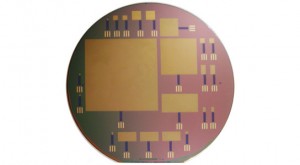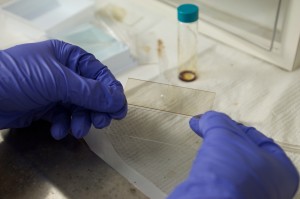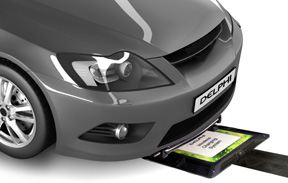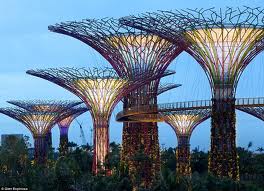Bio-medicine Update: Eat an Apple to Power Your Pacemaker
That is the future of medical implants powered by fuel cells that use glucose (sugar). No external or internal battery pack to replace. Just do what you normally do to fuel yourself and you will keep all the medical devices inside you running.
That’s because fuel cell technology has the potential to use fuel like glucose and a team of engineers at Massachusetts Institute of Technology (MIT) have exploited this in designing one that mimics the way cells process glucose as fuel. Built of silicon with a platinum catalyst, the cell uses the catalyst to strip electrons from glucose molecules creating an electric current. It currently can generate hundreds of micro-watts, enough to power an implanted device. The focus of the team is neural implants. With no requirement for an external power source, these fuel cells can run as long as you keep feeding yourself. So an apple a day sounds like a plan!

Energy Update: Print or Paint on Solar Cells
Sounds like an ideal way to maximize surface areas for power generation. No longer science fiction, University of Southern California researchers recently announced a liquid printable solar cell using solar nanocrystals that are so small you can fit 250 billion of them on the head of a pin. The work at USC follows a December 2011 announcement of a similar nature made by scientists at University of Notre Dame who have developed a solar paint.
The downside to the current technology is poor conversion efficiency compared to traditional photovoltaic technology. The upside is the nanocrystals can be applied to plastic as well as glass. Plastic panels can be flexible and shaped to fit anywhere.
The current nanocrystals use cadmium which is toxic but scientists believe they can work with other materials to perfect this technology and improve power yield efficiency for commercial production.

Space Update: 100 Goldilocks Planets within 30 Light-Years of Earth
A Goldilocks planet is one that has the potential to support life on Earth. That means it’s not too hot, not too cold, just right for liquid water to exist on its surface.
Since astronomers developed the technology to find planets circling neighbouring stars they have been stunned by the sheer numbers. Currently they estimate tens of billions which is why astronomers think there are 100 Goldilocks planets in close proximity to us. By close we mean within 30 light years. Based on our current propulsion systems no one will be going to visit these planets for awhile.
Research at the La Silla Observatory in Chile conducted over 6 years surveyed 102 red dwarfs, the most common stars found in the galaxy. The astronomers identified 9 super-Earths, that is planets between one and ten times the size of our Earth. The methodology detected only a fraction of the total planets around red dwarfs but using the discovery astronomers were able to calculate an estimate that 40% of all red dwarf stars have Goldilocks planets orbiting around them. There are 160 billion red dwarf stars in our galaxy. So you can do the math.
If we within the century (see my predictions in a previous blog) develop propulsion technologies that reach between 10 and 50% sub-light speed it is feasible that robotic spacecraft can journey to these systems. And where robots first go, humans will follow.

Transportation Update: Wireless Recharge for Battery-Powered Vehicles
If electric-powered vehicles are to replace internal combustion engine technology then making recharging accessible anytime a vehicle is parked makes sense. With that in mind the United States Department of Energy is rewarding grants to companies who develop static wireless charging systems for electric cars similar to the Powermat used to charge portable electronics.
Nissan has announced that the Leaf 2013 model will include a wireless charging option transferring power from a ground transmission unit to a receiver on the vehicle using electromagnetic induction. But Nissan’s solution is specific only to its automobiles.
What the Department of Energy seeks is high-efficiency wireless charging technology that works with any vehicle and that can be installed in parking lots and garages. The system would employ electronic payment. Delphi, the automotive parts supplier is working with MIT to develop such a system.
A wireless charging system would include:
- A vehicle capture resonator
- A vehicle power and signal distribution system
- A ground station resonator ad
- A ground station charging controller

Urban Landscapes Update: Singapore Creates City Garden with First Mechanical Forest
The project is called Gardens by the Bay. It features a 101 hectare (250-acre) garden that includes a massive climate-controlled conservatory and the first mechanical forest. The garden opens June 29, 2012. Visitors can experience indoor themed gardens representing flora from around the world, a flower dome, a cloud forest, an exhibit called The World of Plants, and two indoor lakes.
Dominating the landscape are 18 supertrees, varying in height from 25 to 50-meters (80 to 164 feet), made from concrete and steel. Each tree is a vertical garden with the canopy designed to collect rainwater, absorb heat and provide shade for the plants in the gardens below. The trees are also outfitted with photovoltaic cells to generate electricity for lighting and other uses in the gardens. The trees serve an additional purpose as ventilators for the neighbouring conservatory. Each supertree will house over 226,000 plants representing 200 different species.
















